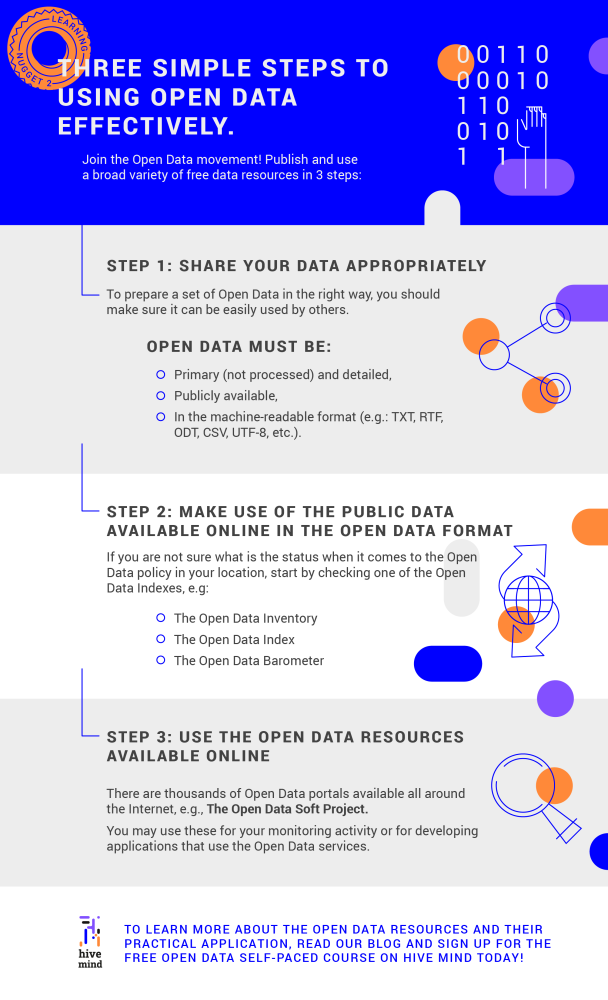Join the Open Data movement: publish and use a broad variety of free data resources!
Open Data is a concept that certain data should be freely available for machine processing and further use and dissemination without any restrictions or control.
Open Data is primarily an opportunity for an easy, efficient, and standardized way of data exchange between all the stakeholders, including the authorities.
Open Data resources are published and made available on the internet in a machine-readable format. They are suitable for automated processing by computer systems and programs.
Citizens, businesses, public organizations, nonprofits, and scientific institutions are free to publish, copy, distribute and use Open Data for economic, social, cultural, or environmental purposes.
Below, you will find the three key steps to share, access, and use the Open Data resources appropriately:
Step 1: Share your data appropriately
If you wish to prepare a set of open data in a proper way, you should make sure it can be easily used by others. For this, you will need to follow certain rules regarding how the data should be published.
Open data must be:
a) Primary (not processed) and detailed,
b) Publicly available,
c) In the machine-readable format.
Incorrectly prepared data, that cannot be read by machines, is useless for further use. The data should be prepared in a certain way and published in the correct format, such as:
Text data
Examples of text data may be reports, regulations, logs, decisions, orders of authorities, notes, etc.
Text data is published primarily in TXT, RTF, ODT formats. You are also allowed to use DOCX and PDF formats without any scanned images.
❗JPG, JPEG, PNG, GIF, TIFF, and PDF with scanned images are not suitable for text data. Publishing data in these formats makes it impossible to process it by automated means, as it needs to be further digitized.
Tabular data
Tabular, or structured, data is an ordered set of columns and rows (such as standard Excel spreadsheets). If your data contains tables, you are dealing with structured data.
Most structured data is found in the CSV format. The XLX(S) format is also available.
Hierarchical data
Information systems usually allow you to export data in JSON or XML format which is often used by administrators to publish data sets. XML and JSON formats are best suited for hierarchical data.
If your data is not hierarchical by nature, the CSV format will be sufficient.
❗DOC(X) RTF, PDF, JPG, JPEG, TIFF and PNG are not suitable for tabular or hierarchical data.
What encoding format is best?
UTF-8 encoding is dominant in most web spaces. This is why you should use it, too.
To learn more on how to prepare your data according to the Open Data standards, please follow the link to the self-paced course that you will find at the end of the article. ⬇️
Step 2: Make use of the public data available online in the Open Data format
You can now find online resources in the Open Data format in many countries. If you are not sure what is the status/ situation when it comes to Open Data policy in your location, start by checking one of the Open Data Indexes; here we can recommend 3 of them:
The Open Data Inventory. It is an inventory run by Open Data Watch. It scores the availability and openness of the data in specific countries. https://odin.opendatawatch.com/
The Open Data Index. The author of the index is Open Data Foundation, and it provides information about transparency and accountability of the government - https://index.okfn.org/place/
The Open Data Barometer, run by the World Wide Web Foundation. The Barometer will show you the Open Data availability in your country, and the openness of the government towards it: https://opendatabarometer.org/?_year=2017&indicator=ODB
Step 3: Use the online resources
You can find the public Open Data information online.
Today, there are thousands of Open Data portals available all around the internet.
The Open Data Soft Project team has compiled a list of almost 4,000 web resources from all around the world. You will find some of the useful resources here: Create the best data experiences - Opendatasoft
You may use these for your monitoring activity or for developing applications that use the Open Data services.
To learn more about the Open Data resources and their practical application, sign up for the free Open Data self-paced course today:
Did you enjoy this blog post? Want to keep it with you or share its essence with your circle? Here's a downloadable infographic that you can save, print and pass on!

